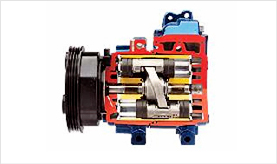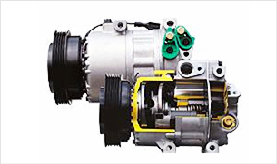Basic Operation Principles of Compressor
Compressor
Pulley assembly
Field coil assembly
The Disc / Hub assembly
Operation principle of compressor
Functions and types of compressor
- 1. Suction : The refrigerant pressure in the evaporator is lowered to evaporate the liquid refrigerant at a low temperature.
- 2. Compression : The vaporized refrigerant is compressed to high temperature and high pressure and sent to the condenser to be liquefied at room temperature.
- 3. Pumping : The refrigerant is purified through the above-mentioned suction and compression process to ensure the continuous operation.
Types and features of compressor
1. Crank type
The piston moves up and down by the crankshaft. The structure is simple with high efficiency. However, the vertical structure is hard to be installed in the engine room.
Increasing the number of cylinders is also a problem along with large torque fluctuation in the crankshaft.
2. Swash plate type
Applying the piston to the shaft in parallel with the rotation of the swash plate, it is advantageous for the complicating structure with heavy weight and small engine room; the torque fluctuation is small.

3. Variable type
The angle of the plate is changed by the suction pressure sensor of the removal valve in the wobble plate type structure to control the discharge amount.

Compressor failure factor
1. Lack of lubricant by insufficient refrigerant
The oil in the air conditioning system circulates with the refrigerant, as moisture sprayed over to the compaction part (swash plate & piston), and plays a role of lubricant. When the refrigerant is insufficient, so is the amount of oil to cause lack of lubricant; at the same time, since the suction temperature of the compressor becomes high due to the malfunctioning air conditioner, abnormal heat is generated to cause premature damage to the moving part.
- ▶ In case of the malfunctioning air conditioner performance, it is necessary to immediately check the refrigerant quantity and refill it.
- ▶ In winter, turn on the air conditioner on a regular basis (once every 2 weeks) to improve the circulation of refrigerant and oil.
2. Compressed fluid by refrigerant inflow
A high pressure by overcharged refrigerant and a non-evaporated gas enter the compressor as a liquid state to cause compressing a liquid; overloading the motion part of the compressor results in damage to the compressor and only operating the pulley.
When the air conditioner operates for the first time after installation, the oil in the compressor flows out and the low-pressure liquid refrigerant enters the compressor; and even the oil applied to the friction surface of the motion part is washed away, which causes a non-lubricated state until the compressor oil circulates.
3. Insufficient lubrication due to clogged refrigerant circuit
EXP-V / V ICING phenomenon, by moisture contained in the air inside the system due to a vacuum failure before injecting the refrigerant, causes blockage to operate the compressor in a non lubricated state, resulting in insufficient lubrication.
- ▶ In the case of water flowing in the vehicle, sufficient vacuum (more than 30 minutes) operation must be performed by refrigerant recovery to remove moisture from the system.
Contrarily, the swash plate type compressor has no automatic sensing ability and depending on the engine RPM, the cooling efficiency varies.
In order to compliment this weakness, we are trying to develop a variable type compressor.

